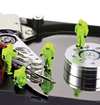Determining the filesystem for storage media
|
Linux can handle a wide variety of filesystems. However, in order to achieve problem-free use of a data storage device, it is a good idea to at least know what type of filesystem is on the device. Attempts to restore data on storage medium that have an unknown filesystem can be very difficult. Similar difficulties occur in situations in which you want to read a downloaded image of a DVD or an unknown data storage device and therefore have to incorporate it in the system. This can also be the case for new media, like recently purchased memory cards.
We take a closer look at the relevant out-of-the-box tools available for determining the correct type of filesystem. After that, we look at the partition and then the integration of the directory, which is made available via the network and the storage medium, into the system.
Mounting a filesystem is accomplished by a user with administrative rights on the mount command. Usually, this means as a root user. As part of the mount procedure, you should enter a mount point that tells the system where it should incorporate the filesystem in the local filesystem tree. If you do not enter a mount point, then the command pulls the prepared partitions or storage media into the filesystems table (/etc/fstab ) in order to find a directory that should serve as the mounting point.
[...]
Buy this article as PDF
Pages: 5
(incl. VAT)






